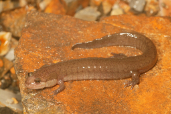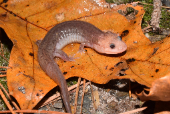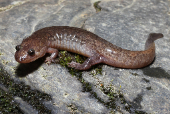Ouachita Dusky Salamander (Desmognathus brimleyorum)
Description: The Ouachita dusky salamander grows to about 7.0 inches in length including a finned tail. The upper side is greenish-brown or grey of a fairly uniform colour and the juveniles have a row of pale spots along each side. There are fourteen costal rib grooves on either side.
Habitat: They live in and near mountain streams and the ravines and woodland close by, on scree slopes, in gravelly areas, on islands and near springs.
Range: The Ouachita dusky salamander occurs in mountainous areas of Arkansas and Oklahoma. Its range includes the Ouachita Mountains, Petit Jean Mountain, Rich Mountain, the Winding Stair Mountain National Recreation Area, the Black Fork Mountain Wilderness, the Kiamichi Mountains and the Potato Hills north of Tuskahoma.
Found in these States:
AR |
OK
Diet: The diet is fairly nonspecific, and they tend to eat whatever is in abundance.
Reproduction: Breeding takes place mainly between July and September. The female deposits twenty to thirty eggs in a grape-like cluster under rocks or in mud chambers usually on land. She broods them until they hatch and then the larvae make their way to water. At first they conceal themselves in the gaps between stones and debris on the streambed.
Status: In the IUCN Red List of Threatened Species, Desmognathus brimleyorum is listed as being of "Least concern". There may be a slow decline in numbers but these have not been quantified and there are thought to be more than 10,000 individuals across its range. The greatest threat is the silting up of the streams where it breeds due to logging activities, but when the streams recover, the salamanders move back into the area.
»» Kingdom: Animalia - Animals
»» Phylum: Chordata - Chordates
»» Subphylum: Vertebrata - Vertebrates
»» Class: Amphibia - (Amphibians)
»» Order: Caudata - Salamanders
»» Family: Plethodontidae - Lungless Salamanders
»» Genus: Desmognathus
»» Species: Desmognathus brimleyorum - Ouachita Dusky Salamander
This article uses material from the Wikipedia article "Ouachita Dusky Salamander", which is released under the Creative Commons Attribution-Share-Alike License 3.0. Content may have been omitted from the original, but no content has been changed or extended.
|












